Learn all about pig farming today as well as how to cook pork chops in a skillet with this incredibly simple recipe that results in a moist, juicy and tender pork chop with butter and garlic.
Last month, I was invited to Springfield, IL with the National Pork Board to take a look at pig farming in America today.
It was a trip I was excited to take as I’ve never been on an actual commercial pig farm (although more dairy and cattle farms than I can count!) but also a tad bit hesitant at the same time.
Let’s be honest, we’ve all seen the Netflix documentaries. We know what the “bad” looks like. And while I have continued to keep pork in my diet, tidbits of those documentaries have stuck with me over time.
I was excited for the trip so I could actually satisfy my curiosity and see with my own eyes what pig farming is really like.
I got back on the plane to NY with a whole new understanding for the business of pig farming in America.
Not to mention, an education on how to break down an entire pig, how to buy the best pork and tips for cooking it.
We’ll get to this easy skillet pork chop recipe in a bit but first let’s talk about the pigs…
*This post is sponsored by the National Pork Board. All thoughts and opinions are my own.
We visited Borgic farm, a 10,000 sow pig farm. Sows are pigs that have given birth at least once before. If a female pig has not yet had a litter, they are called gilts.
Borgic farm, while quite a large operation, is a family run business. We met with the owner, Phil over the course of the trip and what left a lasting impression on me was his passion.
Passion for his family, passion for all 10,000+ pigs in his farm, passion for their care and passion for feeding America in the best way he can. We got to know him and his family, ate lunch at their house and ask him every question under the sun we could think of which he happily and patiently answered.
We saw everything from piglets being born in front of our eyes (some people on the trip even delivered them with their own hands, I opted out of that kind of fun) to piglets right at the end of weaning, pregnant sows waiting out their time until delivery (fun fact: a pig’s gestation is exactly 3 months, 3 weeks, 3 days), to the compost piles, manure pits and wean to finish farms.
Watch this video to see the farrowing barn where the pigs are born.
Watch this video to see the nursery where the piglets grow up.
Of all of that, there are a couple of topics I want to highlight and delve more into.
Animal Welfare in Pig Farming
From even before the trip started, the welfare of the pigs was paramount. I’ve been on a lot of farms but never have I ever had to “shower in and shower out” of a farm before which is exactly what we had to do before visiting the pigs.
This process isn’t just something “visitors” have to do, every single employee does it day in and day out before and after their shift. A sterile environment is key for the health of the pigs and piglets so this is a non-negotiable that’s just part of pig farming life.
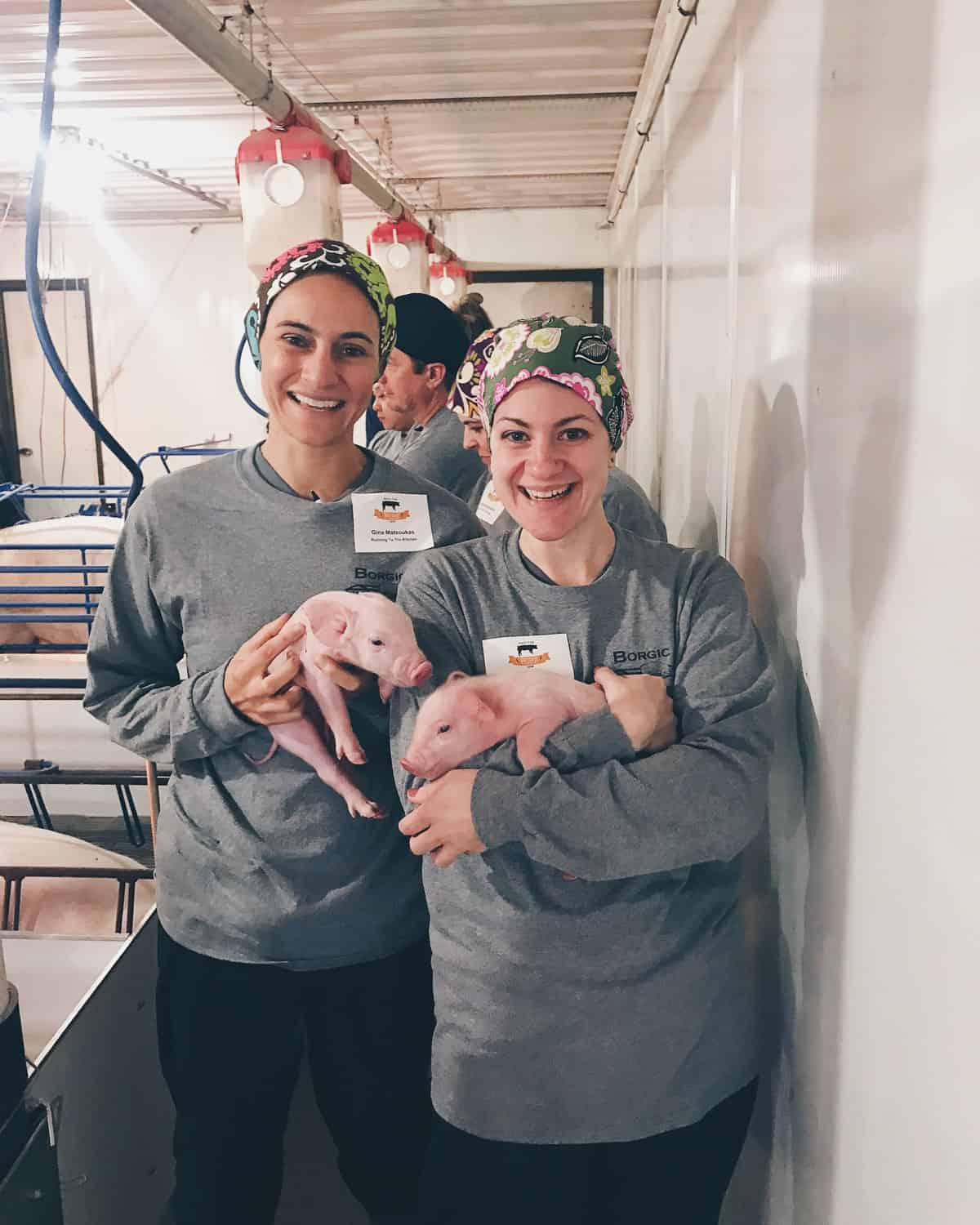
And it’s not just people that have to be sterile coming in either. Every piece of equipment or literally anything that needs to come from the outside world into where the pigs are kept has to be sterilized in a specific clean room using UV light.
The veterinarian is an integral piece of pig farming. Borgic farm’s vet, Dr. Lower, was onsite with us during our visit. He’s on the farm frequently and you’d never know he wasn’t actually part of the farm staff.
He works with the staff to ensure the healthiest environment for the pigs, plays a big part in education when it comes to things like insemination (something they do right there on the farm) as well as treating any emergency situations that arise.
Much like you’d see in any conference room of any business, Borgic farm’s break room had their own core values poster and I think it’s worth sharing:
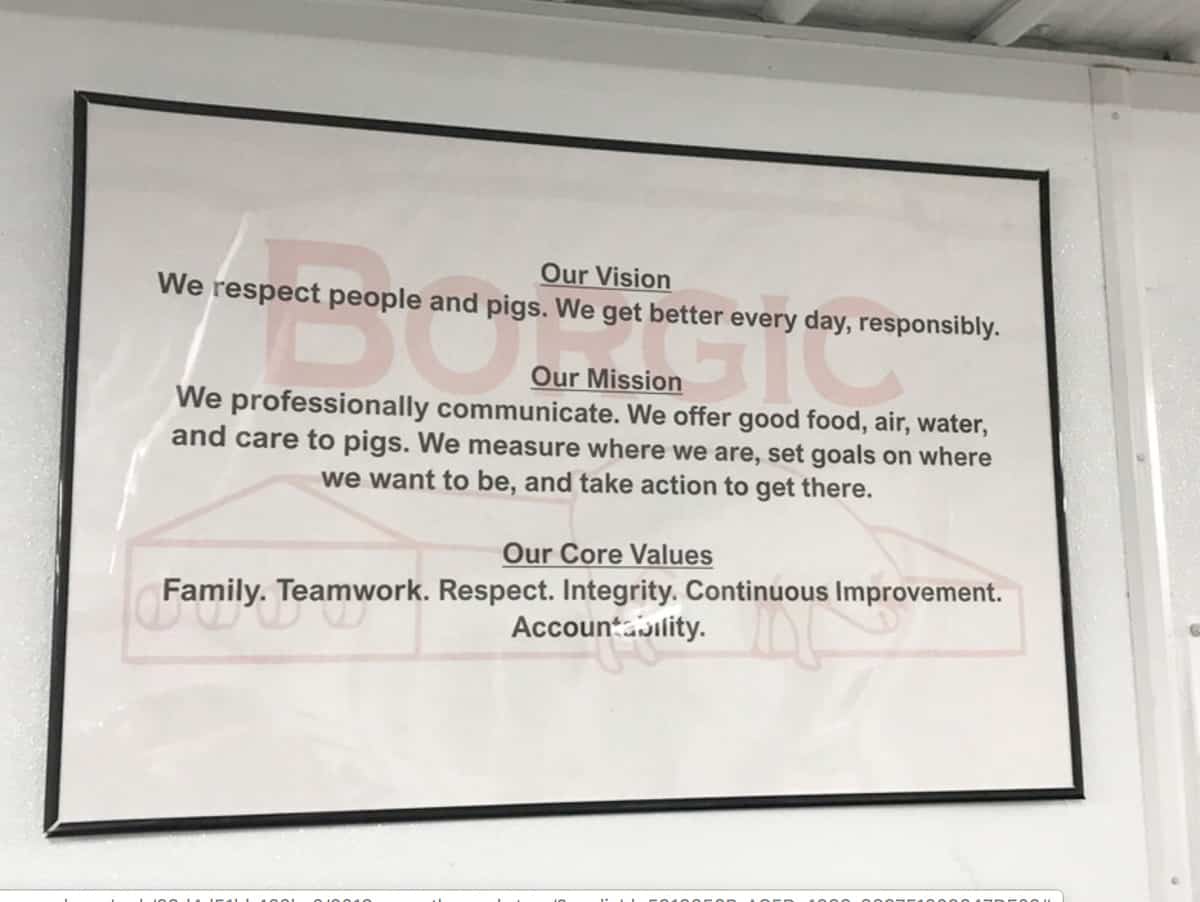
With those core values and their “see it, say it” program that’s strictly enforced and prominently displayed all over the farm in regards to the animal welfare, it’s obvious how much effort and care goes into every facet of day to day pig farming on the farm.
Antibiotic use in pig farming
Antibiotic use is a hot topic when it comes to all animal protein we consume so let’s discuss that in regards to the pigs.
First and foremost, pig farmers don’t want to use antibiotics probably even more than us! The sterilization processes that are in place are there to keep that to a minimum as much as possible.
Antibiotics are expensive for farmers to not only administer but also in the time “lost” on that animal as the medicine leaves their system.
Any time antibiotics have to be used on a pig, the date is marked and there’s a system in place that counts down the days until that medicine will be officially out of the pig’s body (called the “withdrawal time”) to make sure the pig does not get sent to processing and make it’s way into our food chain.
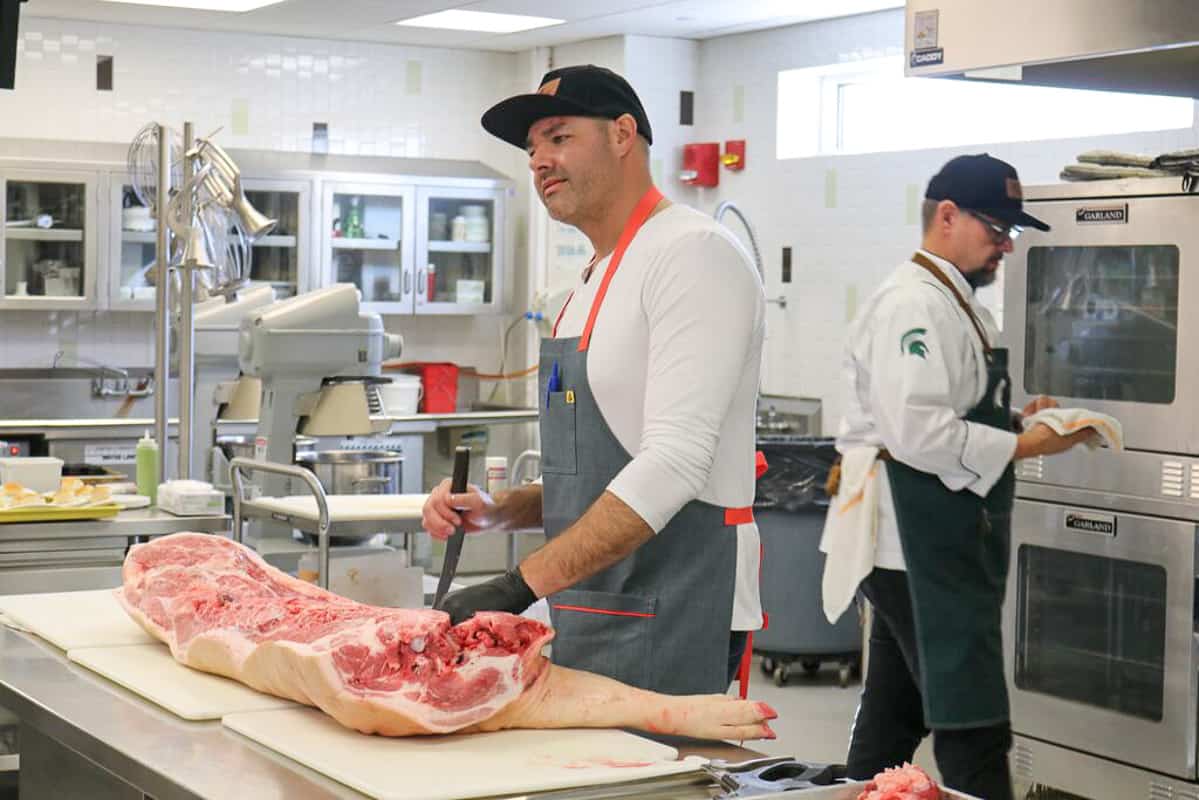
Random testing takes place at the processing plant and if any traces of antibiotic are found in a pig, the farm gets warned upon the first offense. If a second offense occurs, the farm is put on a list and seriously jeopardizes losing its contracts with a processing facility which can be a huge financial impact on a farmer.
The stringency surrounding antibiotics was actually very reassuring. Having heard the worst, I was happy to learn the actual facts with this piece of farming.
Sustainability in pig farming
We learned a lot about the sustainability efforts within pig farming during our trip as well and how it’s changed over time.
Again, coming into this with visions of pig farms spraying manure through the air through standup irrigation systems from documentaries clouded my mind. The truth is far from that though.
The farms we visited were zero runoff farms.
Manure is collected in underground concrete pits that sit directly below the pig barns. It collects there until it’s full and is then pumped out using a huge siphon attachment on a tank that is pulled by a tractor.
That tractor/tank combo (called the “honey wagon”) is equipped with a blade like attachment that digs down a certain depth into the fields (depth is based on soil evaluations and GPS coordinates) and injects the manure directly into the ground for fertilizer.
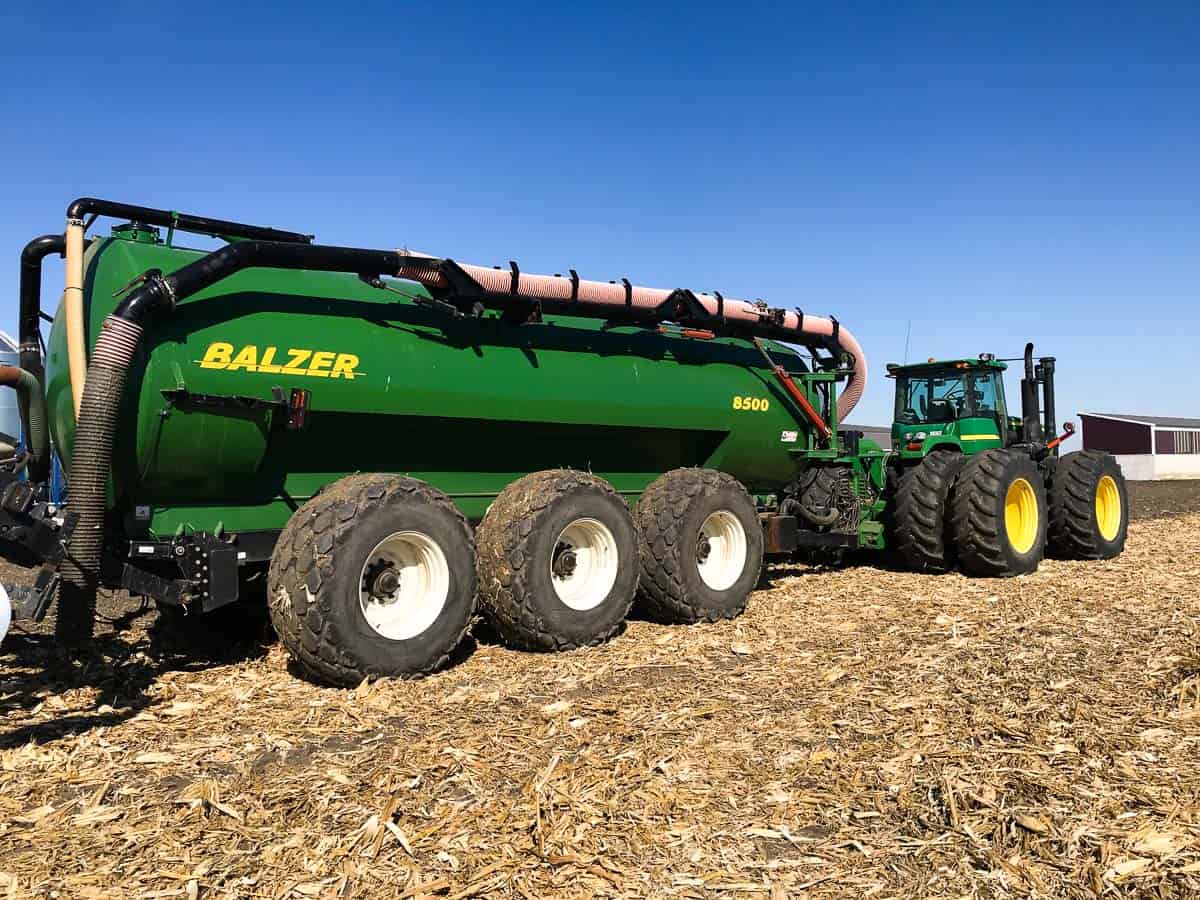
The manure never makes contact with the air and the smell pollution is greatly reduced thanks to this method.
Every farm has setbacks from any water source so that no run-off can occur even if below ground and modern farm tractors are all equipped with some pretty impressive GPS systems that track all of this so human error doesn’t even factor in.
It’s an impressive system and I have to say, I was shocked at the technology in place. The tractor/manure tank set up can run upwards of $500,000. Farming is not cheap nor easy to get into these days. In fact, the “business” behind it all was eye-opening for me.
Some other fun sustainability facts:
Today’s pig farms use 25.1% less water, 7.7% less carbon and 7% less energy than they did in 1960. Greenhouse gas emissions from pork in the U.S. account for just 0.46% of the country’s total.
From farm to table
I got a decent amount of comments on Instagram during the trip from people saying something along the lines of “how can you hold a piglet and then eat it?!”
And I realize it is a bit odd/morbid to be gushing over piglets that eventually become our food but such is the reality if you choose to eat meat.
For me, I actually felt better about my choice to consume animal protein after visiting the farms knowing the care and respect that goes into each and every pig and how the process actually works.
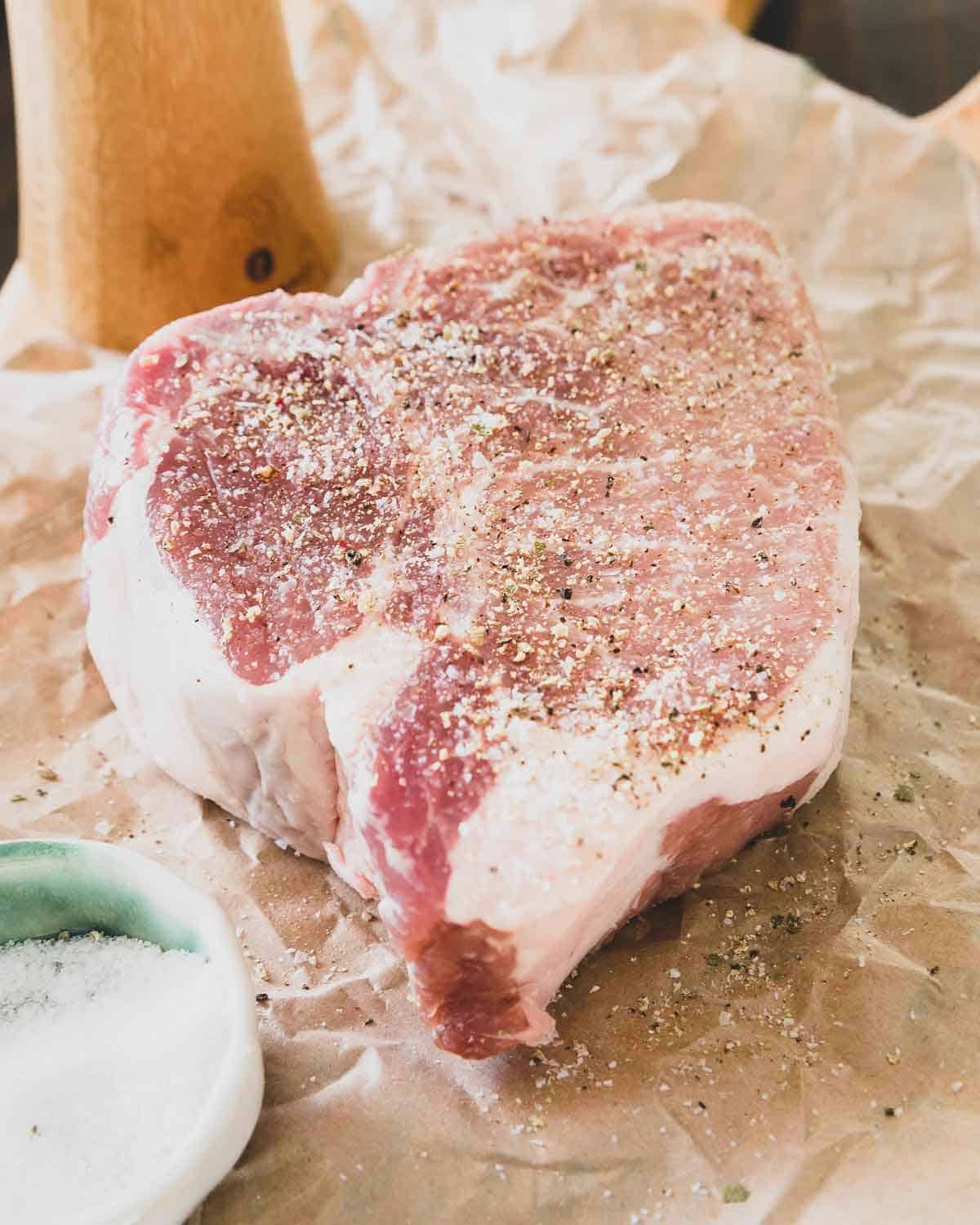
Different cuts of pork
The second day of our trip was spent with 2 chefs breaking down an entire half of a pig into different cuts that you’d see in the grocery store or butcher shop as well as learning tips and tricks while shopping and cooking.
I always find graphics like this helpful in visualizing where the meat I’m picking out of a grocery fridge is actually coming from on the animal.
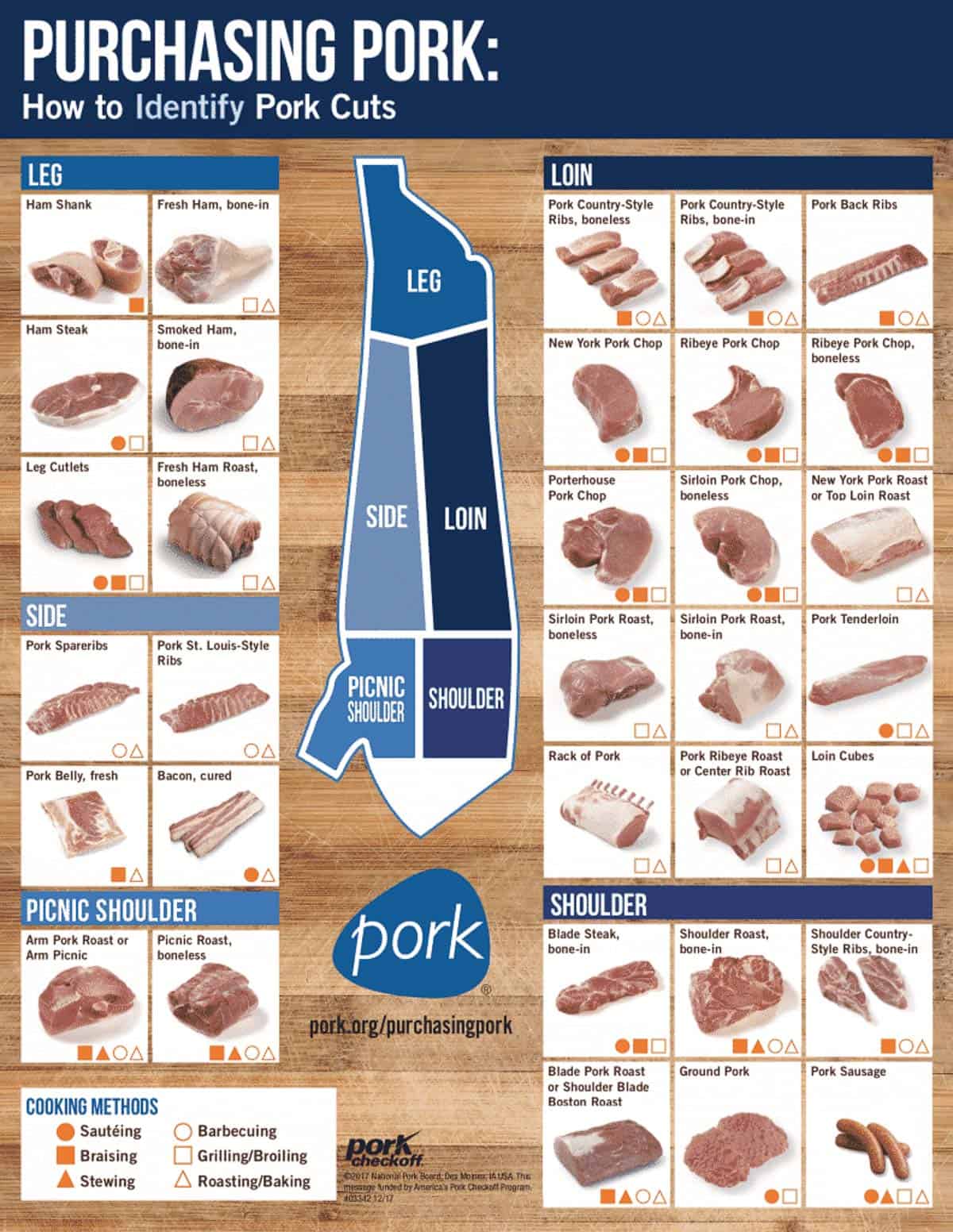
Fun fact: the “Boston butt” cut of meat you’ve likely seen before is not in fact from the rear of the pig but rather the shoulder!
How to shop for pork
Chef Neel passed around 4 different pieces of raw pork chops during his demonstration. The variation in color, moisture and general appearance was striking. We learned that there are 3 things to look for in choosing pork at the store:
- Color – pork should be reddish in color not white! Color equates to moisture which is a good thing!
- Firmness – pork should be firm and sort of “spring back” when touched.
- Water retention – water/moisture should remain in the pork itself not be leaking out into the packaging. If you see lots of reddish liquid in the packaging, stay away from that one. It means the meat has lost its moisture already and will result in a drier texture when cooked.
Pork cooking temperature
“The other white meat” might have single handedly ruined pork for a lot of people.
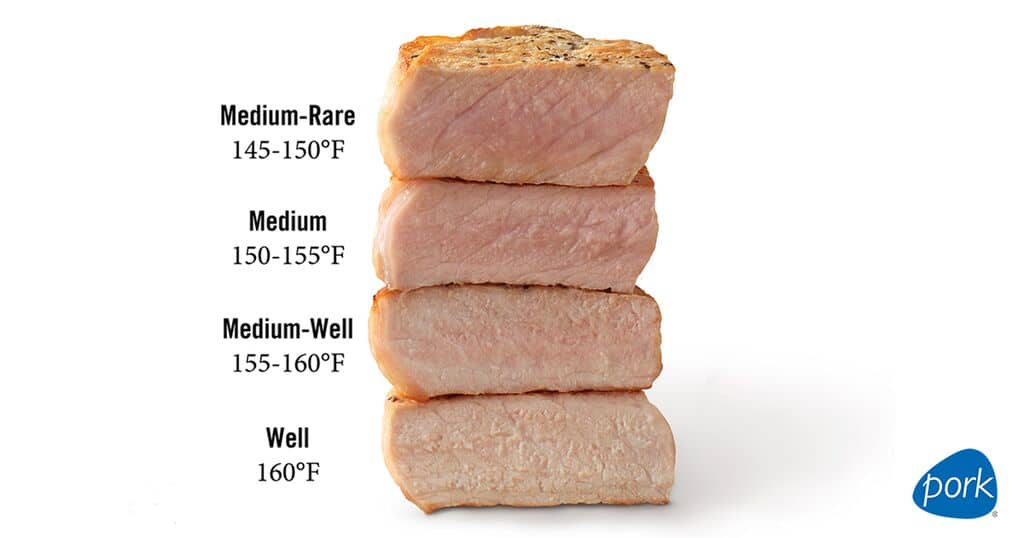
Yes, it’s “white-ish” when cooked but a nice pink hue to the center is a good thing and completely safe to consume when it comes to pork!
If I took away anything from this trip it’s that pork should be cooked to 145°F with a 3 minute rest! Exactly like how it’s done in this pretzel crusted pork chop recipe and these easy sheet pan pork chops.
How to make the easiest skillet pork chops
Now that we covered pig farming, pig sustainability, cuts of pork, how to shop for pork and how to cook pork, let’s get to this amazing skillet pork chop recipe.
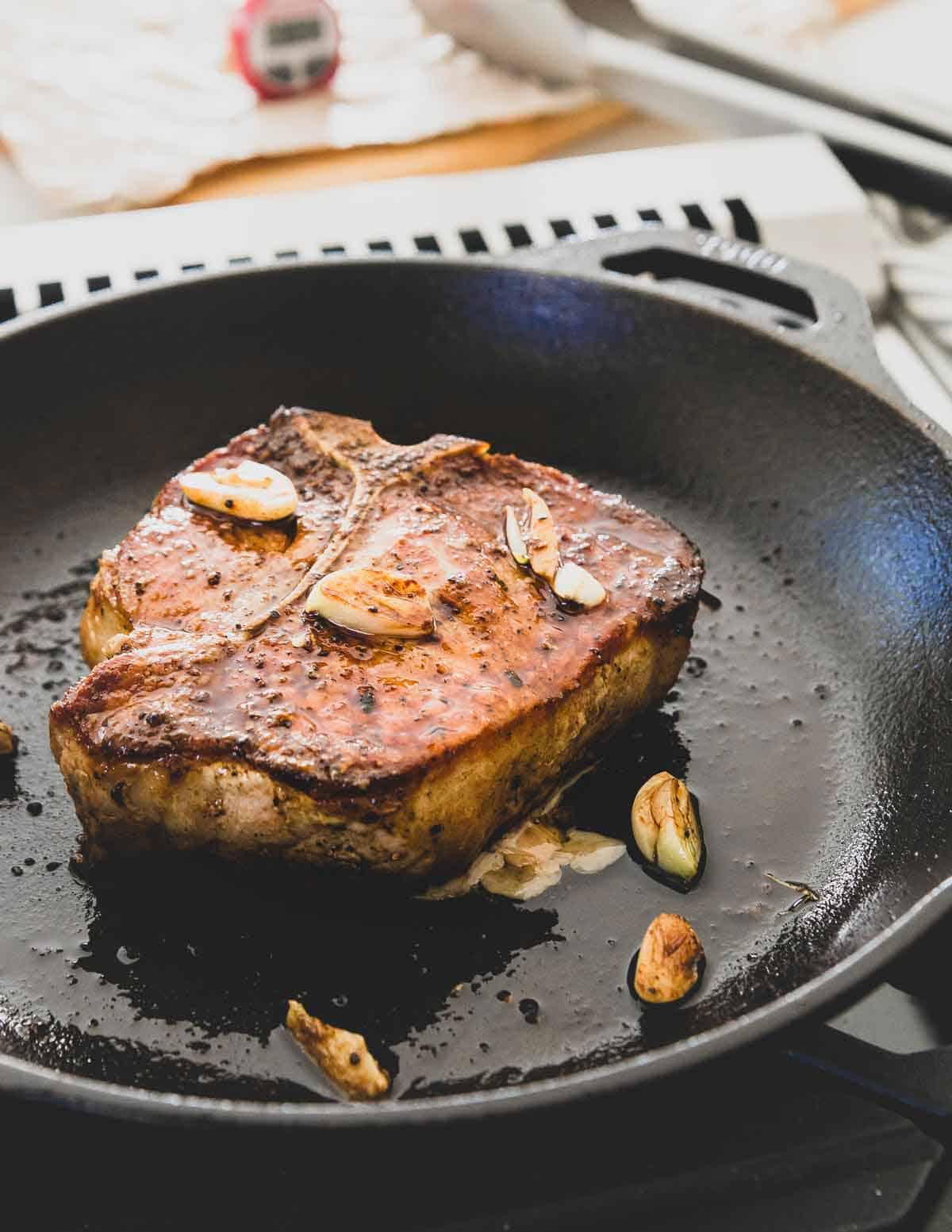
I swear it’s the best and so incredibly easy.
With this skillet method, I may never grill my pork chops again!
There are just 4 ingredients to these skillet pork chops (not counting the pork itself) but your tastebuds will be in heaven upon first bite.
- bone-in thick cut pork chops (like thick! I’m talking 1.5″ minimum, preferable 2+)
- kosher salt
- black pepper
- ghee (aka clarified butter)
- garlic cloves
Oh, and a cast iron skillet. It’s a crucial component to the perfectly seared pork chop.
As far as simplicity goes, besides this skillet seared duck breast recipe (and maybe this blackened cod), I don’t think there’s any easier recipe on this site!
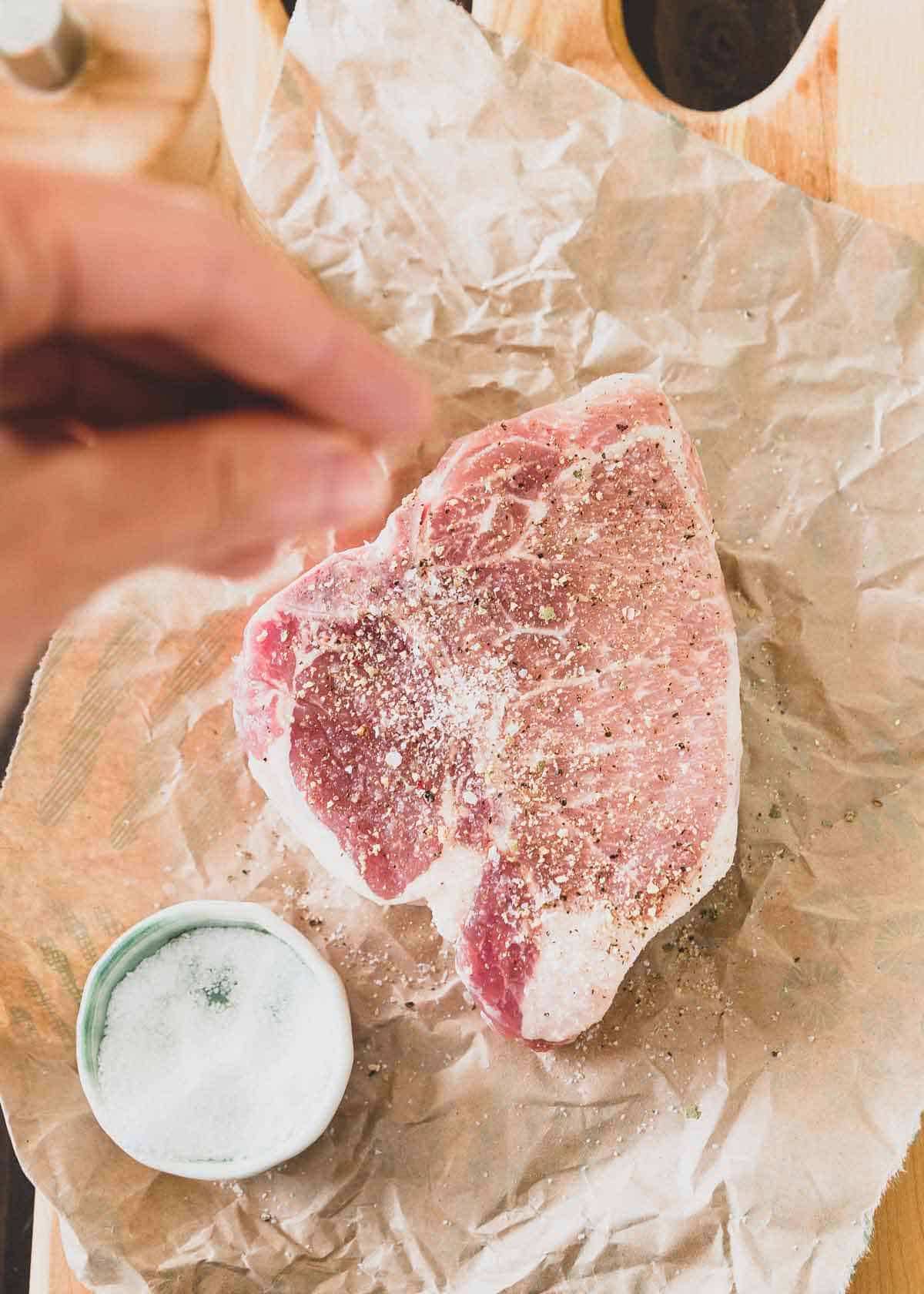
- Season the pork very generously. Be liberal with that salt!
- Melt half the ghee in the skillet over medium-high heat.
- Place the pork chop (or chops) in the hot skillet and leave it alone until a nice golden brown edge forms.
- Flip the chop every minute until golden brown on both sides and the internal temperature reaches 145°F using an instant read meat thermometer.
- Turn the heat off, add the remaining ghee and throw the garlic cloves in the pan to infuse the ghee as it melts and sizzles.
- Tilt the pan to the side to be able to spoon the garlic ghee mixture over the pork chops a few times for added flavor.
- Let the pork rest another 1-2 minutes before serving.
- Clean the cast iron skillet.
Alternatively, you can try the reverse sear method for cooking a thick-cut pork chop like these. It takes a little longer but always results in a perfectly even cooked piece of meat.
Can I use oil instead of ghee?
Yes, you can but choose one with a high smoke point. Avocado oil is a good choice for this method.
Why turn the pork every minute?
This method keeps any one side from burning/blackening too much and ensures a nice even cook. It’s a little more hands on but just set the stopwatch on your phone and be diligent about it.
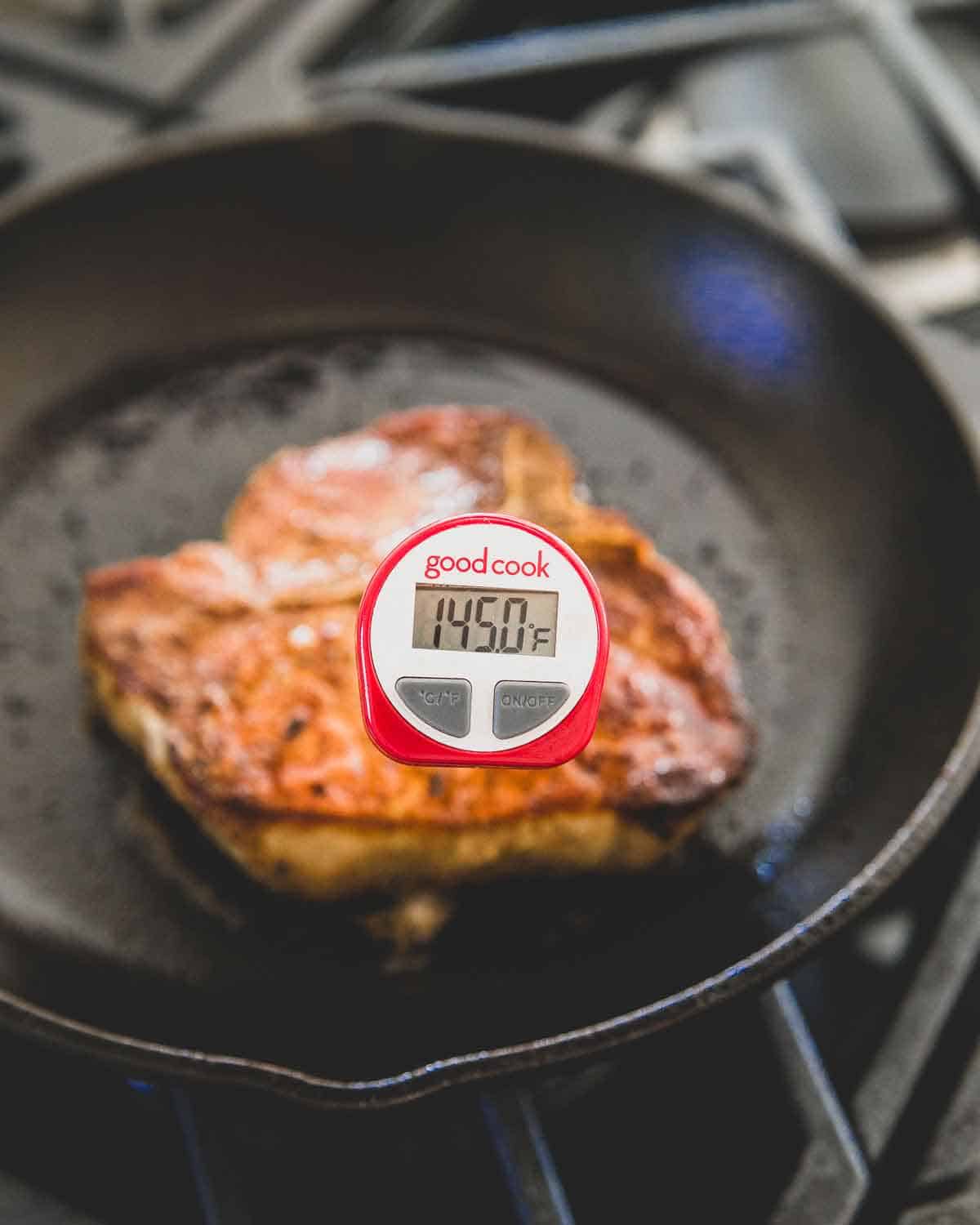
Can I use other seasonings?
I love keeping steaks and chops simple when I pan fry them with just good quality salt and pepper. But yes, you can add in whatever other seasonings you like.
If you have any fresh herbs on hand like sage, rosemary or thyme, those would also be great to throw in the skillet at the end with the garlic.
These skillet pork chops may not seem like much but this quick method produces the BEST pork chop you’ll taste.
It goes with almost any side dish and there’s just something about mastering the simplicity of a nice thick cut chop that will have you patting yourself on the back after making this.
Try serving with these roasted Stokes purple sweet potatoes or these easy roasted pesto potatoes along with your favorite green vegetable to round out the meal!
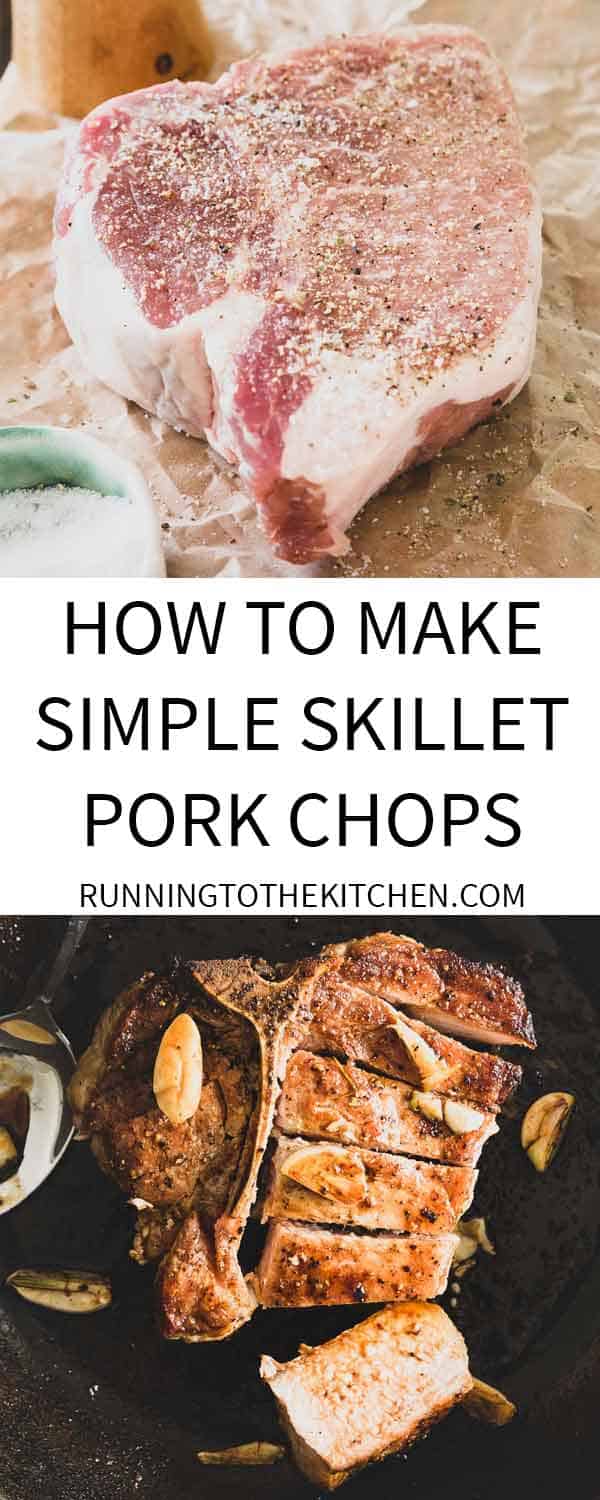
Be sure to check out more pork chop recipes like these Grilled Pork Chops with Grapes and Fennel, Harissa Rubbed Grilled Pork Chops with Tomato Peach Salad, Spice Rubbed Pork Chops with Mango Peach Chutney and this old favorite: Sticky Honey Soy Pork Chops.
This other skillet pork chop recipe: Pumpkin Tea Glazed Pork Chops and Apples is perfect for this time of year too, don’t miss that one either!
If you prefer baking pork, this recipe for simple baked pork chops is a good one to check out with lots of helpful info. Have a Blackstone griddle? Try these fried pork chops.
For grilling, check out Amanda’s grilled bone-in pork chops – another simple but seriously flavorful recipe!
Simple Skillet Pork Chops
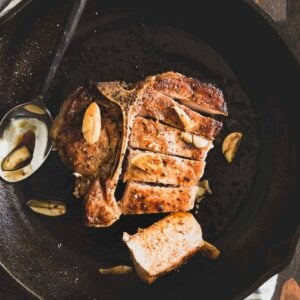
Ingredients
- 1 pound bone-in pork chops, about 1.5″ -2″ thick
- kosher salt
- freshly ground black pepper
- 2 tablespoons ghee, divided (*see note)
- 2 cloves garlic, smashed and sliced
Instructions
- Set the pork chop(s) out on a cutting board at room temperature for about 10-15 minutes before you begin cooking.
- Season both sides of the pork liberally with kosher salt and freshly ground pepper.
- Place 1 tablespoon of the ghee in a cast iron skillet on the stove top over medium-high heat.
- Once melted and hot, place the pork in the skillet and cook until bottom starts to turn golden brown around the edges (about 3-4 minutes).
- Flip the pork cooking an additional minute on the other side and continue flipping back and forth each minute until both sides are a nice golden brown and a temperature of the meat reaches 140-145°F using a meat thermometer (about an additional 10 minutes depending on how thick your pork chops are).
- Turn the heat off, add the remaining tablespoon of ghee to the skillet and place the smashed garlic cloves in the ghee.
- Let the garlic cook for about 1 minute then tilt the skillet and spoon the ghee infused garlic over the pork chops a few times for flavor.
- Let the pork rest another 1-2 minutes before serving.
Notes
Nutrition
Nutrition information is automatically calculated, so should only be used as an approximation.
Gina Matsoukas is an AP syndicated writer. She is the founder, photographer and recipe developer of Running to the Kitchen — a food website focused on providing healthy, wholesome recipes using fresh and seasonal ingredients. Her work has been featured in numerous media outlets both digital and print, including MSN, Huffington post, Buzzfeed, Women’s Health and Food Network.

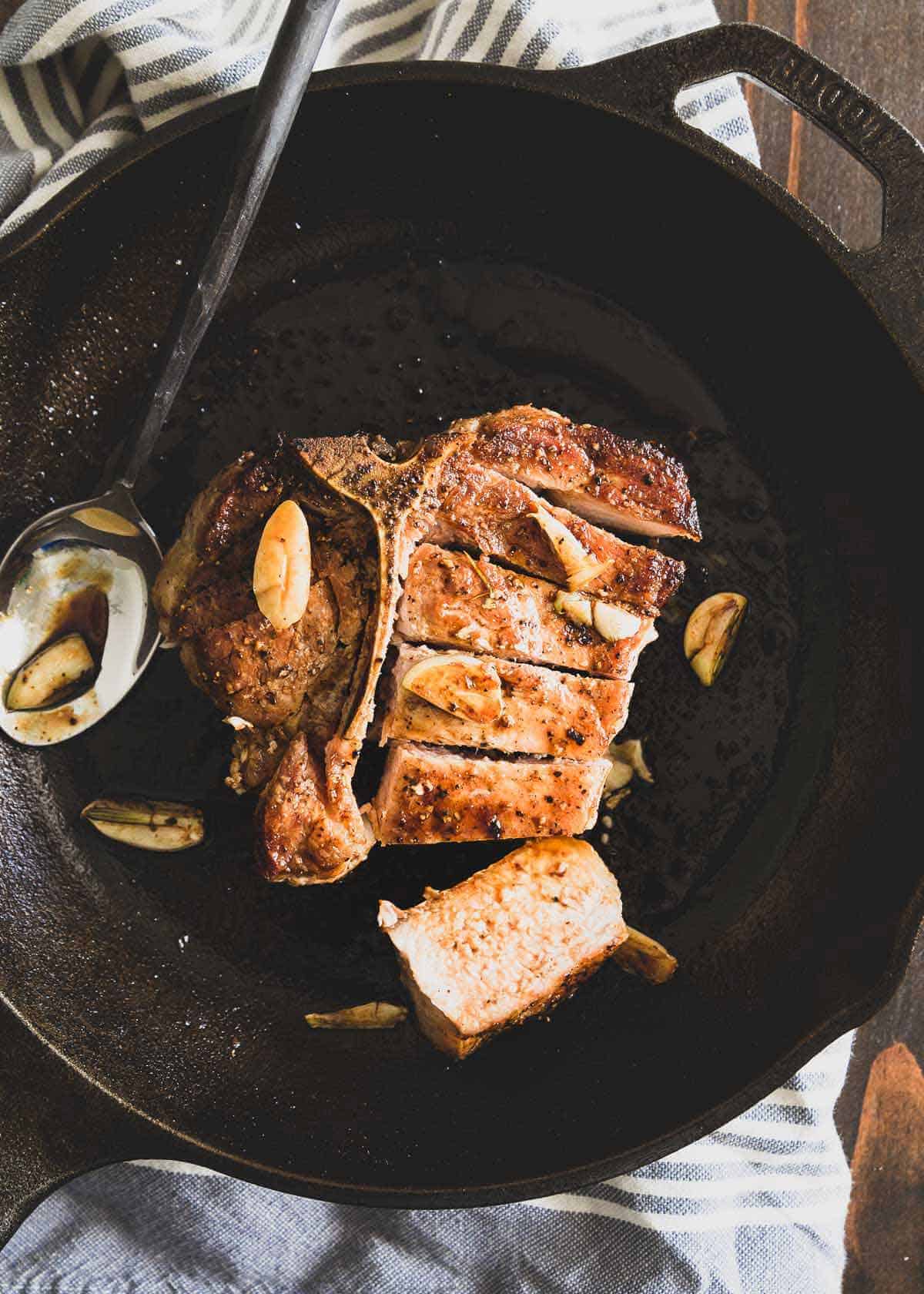
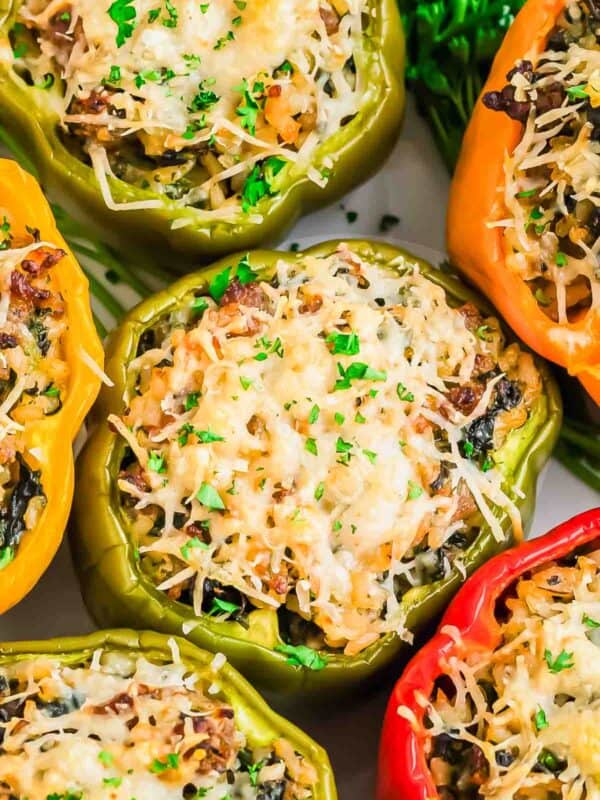
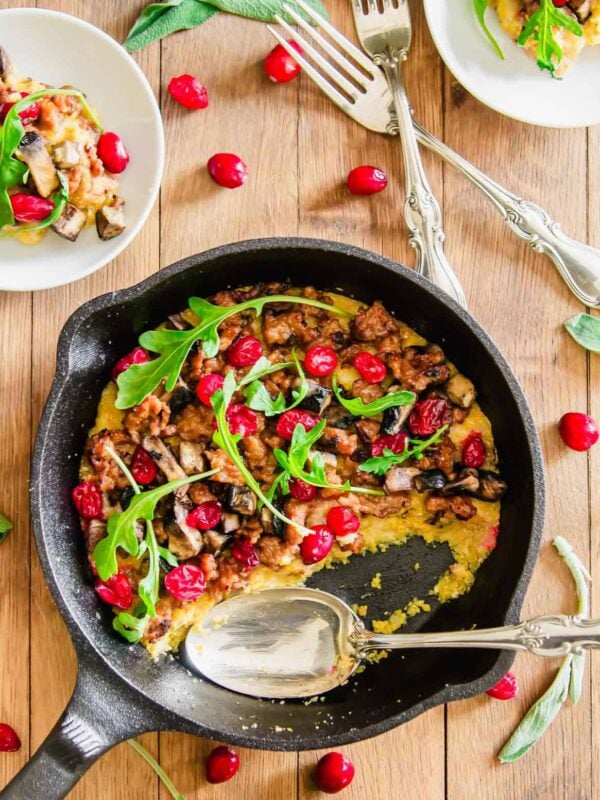
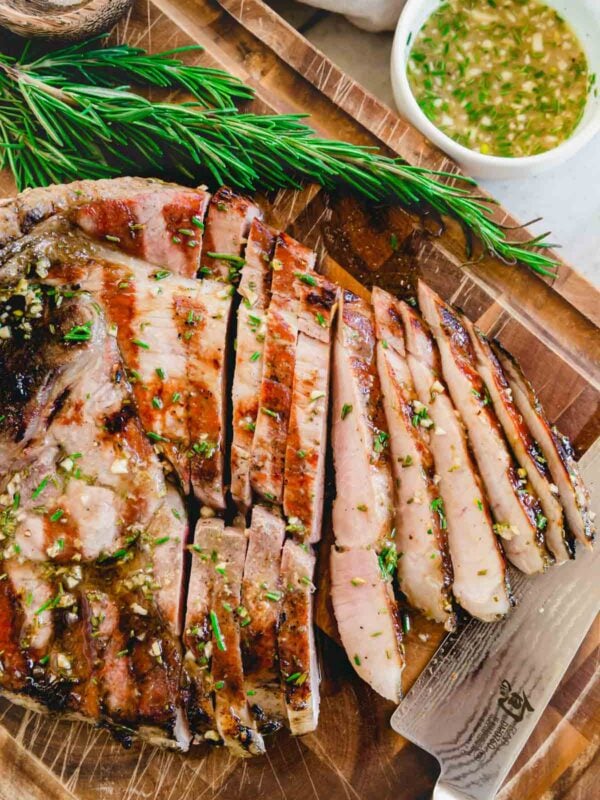
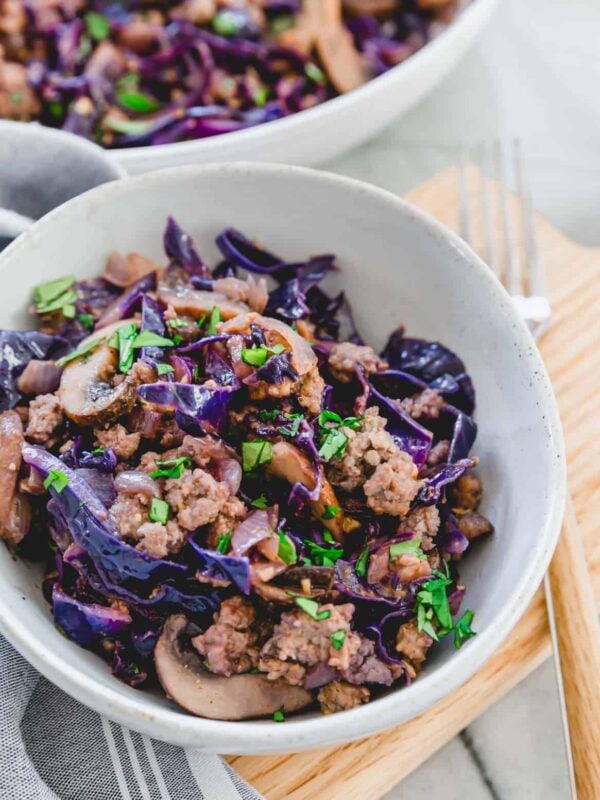








I not a big fan of pork but will surely try out this recipe
I love these pork chops! I made them for a date night dinner with my husband, huge hit!
I love these pork chops! I made them for a date night dinner with my husband, huge hit!